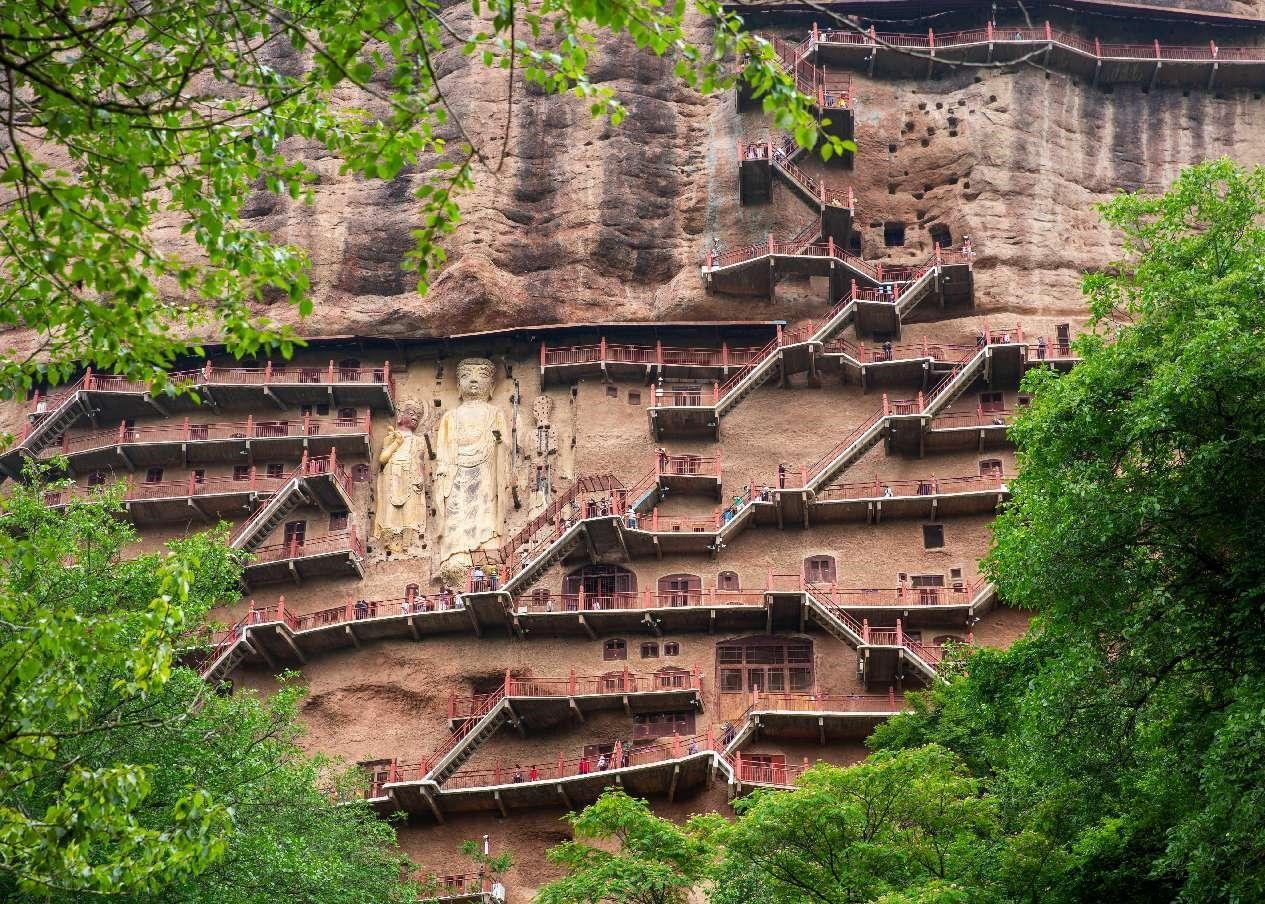Cultural relic workers dedicated to protection of Maiji Mountain Grottoes in NW China's Gansu
From:People's Daily OnlineAuthor: 2024-10-09 15:22
The Maiji Mountain Grottoes in Tianshui city, northwest China's Gansu Province, contain 221 existing caves spanning a cliff face that house more than 10,000 sculptures and over 1,000 square meters of murals.
First built in the Later Qin (384–417) era of the Sixteen Kingdoms period, and constructed and restored in over 10 dynasties, it is one of China's four largest Buddhist cave complexes, along with the Mogao, Yungang and Longmen grottoes in Gansu, Shanxi and Henan provinces respectively.
The Maiji Mountain Grottoes were inscribed on the UNESCO World Heritage List in 2014 as part of the "the Silk Roads: the Routes Network of Chang'an-Tianshan Corridor".
?
Tourists visit the Maiji Mountain Grottoes in Tianshui, northwest China's Gansu province. (People's Daily Online/Wang Wensuo)
To protect the Maiji Mountain Grottoes, cultural heritage conservationists have remained steadfast in the mountains, accompanied by the silent caves, continuously updating their methods of cultural relic preservation, safeguarding these precious historical and cultural treasures.
Inside the grottoes, cultural relic restorers work with surgical precision, carefully scraping away dirt to reveal the original splendor of murals and sculptures. This painstaking work has been the daily routine at the Maijishan Grottoes Art Research Institute for decades.
Zhang Bin, one of these skilled restorers, beams with pride each time he enters the caves, marveling at the unique artistic value of the grottoes.
The team's approach is far from one-size-fits-all, as each sculpture and mural has specific restoration requirements due to differences in age and materials used. They even source specific soil from the surrounding area and carefully select water for mixing, ensuring authenticity in their restoration work.
Decades of efforts have led to the development of techniques to address problems like cracking and detachment, enabling the team to restore artifacts' appearance based on how they looked in the past.
Outside the caves, a walkway stretching over 1,300 meters snakes along the cliff face. It serves as the grottoes' lifeline, according to Yue Yongqiang, deputy director of the research institute.
When Feng Guorui, a scholar, visited the grottoes in 1941, he found most of the walkway in ruins. The grottoes' fortunes have drastically improved since the founding of the People's Republic of China in 1949.
In October 1952, Chang Shuhong, a cultural relic worker from Dunhuang city in Gansu Province, led a team to carry out a survey of the grottoes and built a new section of walkway on the west cliff of the grottoes under the support of the local government. Since 1977, a comprehensive eight-year renovation project for the walkway ensured safe access to all caves.
"Over the past 40-plus years, we have continuously maintained and reinforced the walkway, providing the basic conditions for the protection, research and promotion of the culture of the Maiji Mountain Grottoes," Yue said.
Today, traditional conservation techniques are complemented by cutting-edge technologies. Analytical instruments like X-ray diffractometers and fluorescence spectrometers aid guardians of the grottoes in analyzing materials and craftsmanship of sculptures and murals, providing science-based data for making precise protection plans. A microenvironment monitoring platform for the grottoes has been put into operation since 2017.
Currently, a risk monitoring and early warning system for the grottoes' cultural relics has been built by leveraging cutting-edge technologies including the Internet of Things, cloud computing, and big data, ensuring the finding and handling of potential risks at the earliest time possible.
In 2017, the Maijishan Grottoes Art Research Institute was placed under the management of the Dunhuang Academy, signifying that the digitalization of the grottoes would be on a fast development track.
So far, detailed digital records of more than 10 caves of the grottoes have been created thanks to the deployment of computer graphics, photography, and 3D scanning. With 3D printing technology, life-size replicas of some sculptures from the grottoes have been produced, allowing for off-site exhibitions of these relics. In addition, an online touring platform of the grottoes allows visitors worldwide to immerse themselves in the unique charm of grotto art from their smartphones.
"We're using digital methods to safeguard our cultural heritage, with the aim of enabling more people to appreciate the Maiji Mountain Grottoes," said Sun Yuan, deputy director of the digital center of the Maijishan Grottoes Art Research Institute.
Edit:孫儷洋
The copyright of the article and the picture belongs to the original author. If there is any infringement, please contact to delete it